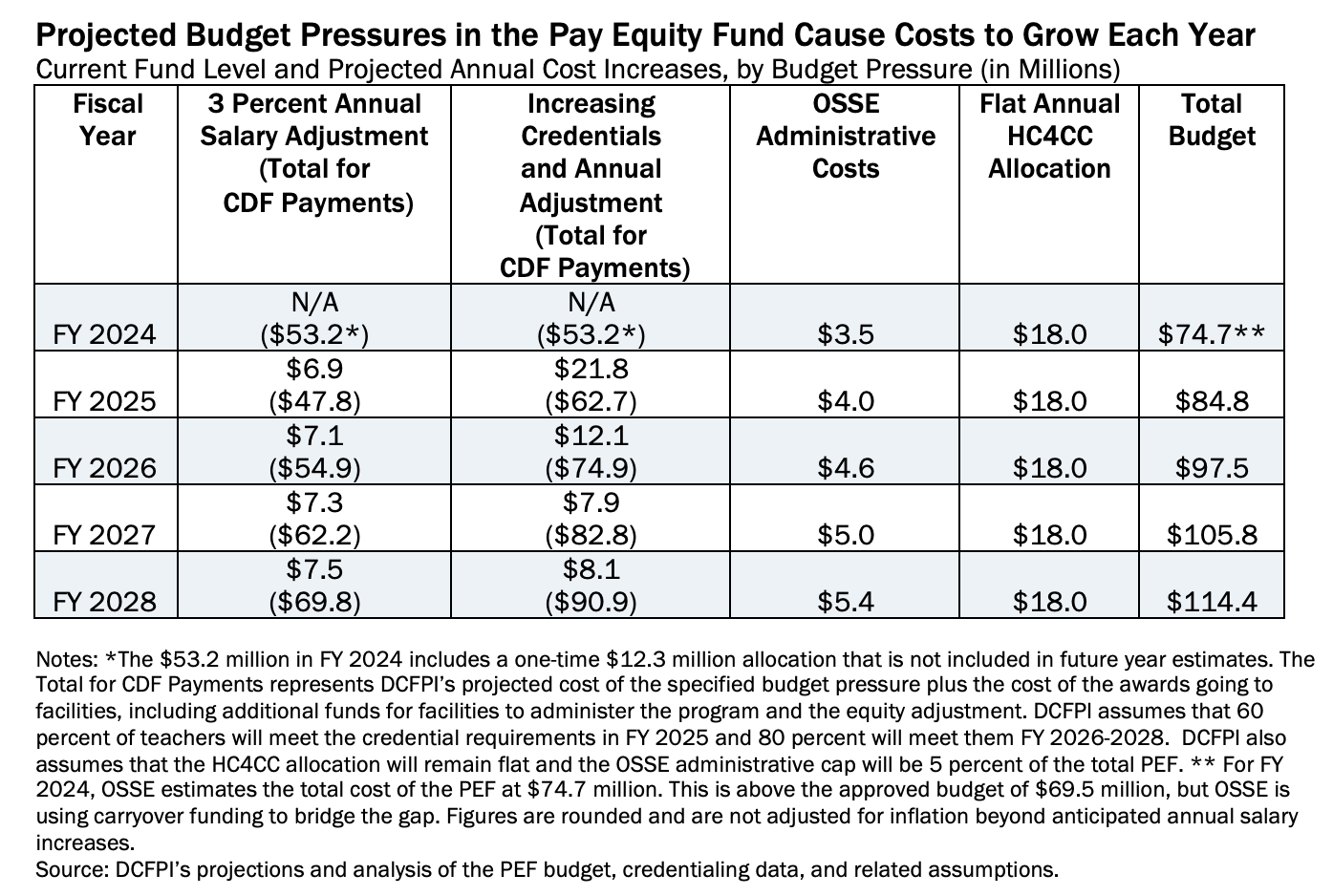Paying early childhood educators livable salaries is one step needed to boost teacher satisfaction, retention, and quality care, thereby improving DC’s early learning system.[1] Nearly 4,000 early childhood educators, most of whom are long underpaid Black and brown women, have received supplemental wage increases since the launch of the District’s Pay Equity Fund (PEF) in 2022, and over 1,000 educators and their families have been covered by the PEF health care program, HealthCare4ChildCare (HC4CC).
As DC local fund revenue growth slows, lawmakers must protect the PEF from another funding raid and anticipate the natural growth in cost that accompanies its successful implementation and outcomes in future years. While fiscal year (FY) 2024 funding is enough for what is required in the law and for those who are currently eligible—thanks to prior year carryover dollars—additional funding will be needed in future years as teacher salaries rise, more early educators qualify for higher salary levels due to higher credentials, and administrative costs increase. Program improvements that would enhance equity also would increase costs, if adopted.
The DC Fiscal Policy Institute (DCFPI) estimates that natural growth in costs to the program will be:
- $6.9 million alone for a projected 3 percent adjustment to minimum salaries in the PEF to account for anticipated Washington Teacher Union (WTU) contract negotiations.
- Or, up to $21.8 million for the projected salary adjustment plus the cost for higher award payments to child development facilities (CDFs) as more early childhood educators attain new credentials to comply with DC law and qualify for higher minimum salaries, assuming DC sees a sizeable increase in credential attainment.[2]
- And, $561,000 for additional administrative costs that the Office of the State Superintendent of Education (OSSE) may need to run the program under these combined cost pressures.
- Some of the higher cost could be offset with recurring revenue that is already in the financial plan for FY 2025 (when backing out the one-time $12.3 million supplement in FY 2024), and any of the remaining $7.3 million in carryover dollars from FY 2023 that may be available at the end of FY 2024.
Table 1 details the current FY 2024 PEF program costs and the amount of funding DC lawmakers need to invest in the PEF for FY 2025 through FY 2028, if it were to keep up with projected rising costs of the program and under DCFPI’s assumptions. The total for each year also assumes continuation of the $18 million allocation for HC4CC and administrative costs that are capped at the maximum-allowed level of 5 percent of the total PEF appropriation.

Lawmakers should also prepare for increases in future years to account for growing costs, such as improving the funding formula and increasing numbers of educators gaining the credentials required under law. Additionally, if lawmakers pursue a fully equitable system and choose to adopt the full salary scale that rewards educators’ experience as intended by the PEF and Birth-to-Three for All DC Act, the additional cost would grow to $33.6 million in FY 2025, when also accounting for the anticipated 3 percent adjustment and credential increase.
The purpose of the PEF is to bolster wages for early childhood educators to achieve pay parity with DCPS educators. To accomplish this, lawmakers should increase funding levels for the PEF to include an annual 3 percent salary adjustment, keep up with increasing credential attainments, and implement a salary scale based on credential level and years of experience. These changes are costly, but necessary to achieve the promise that lawmakers made in the Birth-to-Three Act.
To learn more and to see the methodology DCFPI uses in this analysis, read the full report at bit.ly/dcfpi-pef.
[1] Rob Grunewald, Ryan Nunn, and Vanessa Palmer, “Examining Teacher Turnover in Early Care and Education,” April 2022.
[2] The estimates in the first two bullets reflect the additional costs that higher salaries and credentials will have on award payments to providers (due to the administrative enhancement and equity adjustment).
